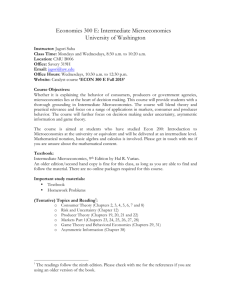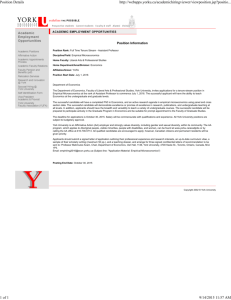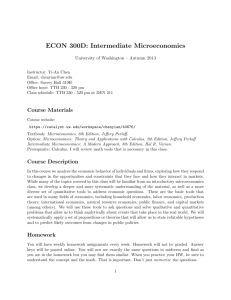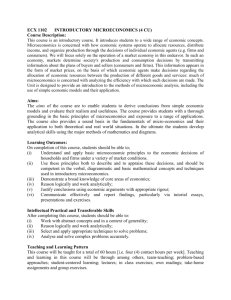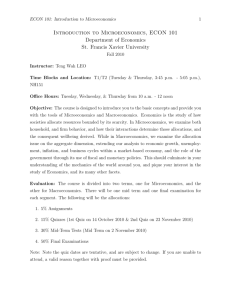Chapter 13 - Department of – Economics
advertisement
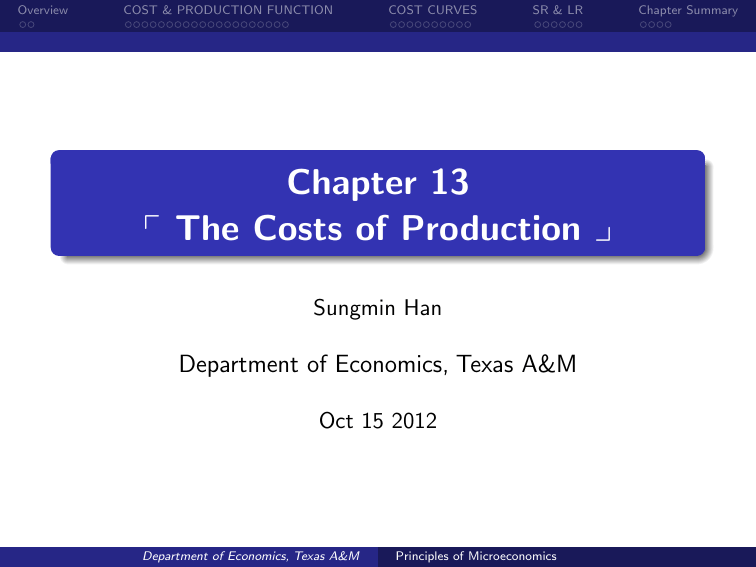
Overview COST & PRODUCTION FUNCTION COST CURVES SR & LR Chapter 13 p The Costs of Production y Sungmin Han Department of Economics, Texas A&M Oct 15 2012 Department of Economics, Texas A&M Principles of Microeconomics Chapter Summary Overview COST & PRODUCTION FUNCTION COST CURVES SR & LR Chapter Summary Look for the Answers to These Questions What is a production function? What is marginal product? How are they related? What are the various costs, and how are they related to each other and to output? How are costs different in the short run vs. the long run? What are “economies of scale”? Department of Economics, Texas A&M Principles of Microeconomics Overview COST & PRODUCTION FUNCTION COST CURVES SR & LR Total Revenue, Total Cost, Profit We assume that the firm’s goal is to maximize profit. Figure 1: Total Profit Department of Economics, Texas A&M Principles of Microeconomics Chapter Summary Overview COST & PRODUCTION FUNCTION COST CURVES SR & LR Chapter Summary Costs: Explicit vs. Implicit Explicit costs require an outlay of money, e.g., paying wages to workers. Implicit costs do not require a cash outlay, e.g., the opportunity cost of the owner’s time. Remember one of the Ten Principles: The cost of something is what you give up to get it. This is true whether the costs are implicit or explicit. Both matter for firms’ decisions. Department of Economics, Texas A&M Principles of Microeconomics Overview COST & PRODUCTION FUNCTION COST CURVES SR & LR Chapter Summary Explicit vs. Implicit Costs: An Example You need $100,000 to start your business. The interest rate is 5%. Case 1: borrow $100,000 explicit cost = $5,000 interest on loan Case 2: use $40,000 of your savings, borrow the other $60,000 explicit cost = $3,000 (5%) interest on the loan implicit cost = $2,000 (5%) foregone interest you could have earned on your $40,000. In both cases, total (exp + imp) costs are $5,000. Department of Economics, Texas A&M Principles of Microeconomics Overview COST & PRODUCTION FUNCTION COST CURVES SR & LR Chapter Summary Economic Profit vs. Accounting Profit Accounting profit = total revenue minus total explicit costs Economic profit = total revenue minus total costs (including explicit and implicit costs) Accounting profit ignores implicit costs, so it’s higher than economic profit. Department of Economics, Texas A&M Principles of Microeconomics Overview COST & PRODUCTION FUNCTION COST CURVES SR & LR Chapter Summary Economic Profit vs. Accounting Profit : An Example The equilibrium rent on office space has just increased by $500/month. Compare the effects on accounting profit and economic profit if you rent your office space you own your office space Department of Economics, Texas A&M Principles of Microeconomics Overview COST & PRODUCTION FUNCTION COST CURVES SR & LR Chapter Summary Answers The rent on office space increases $500/month. You rent your office space. Explicit costs increase $500/month. Accounting profit & economic profit each fall $500/month. You own your office space. Explicit costs do not change, so accounting profit does not change. Implicit costs increase $500/month (opp. cost of using your space instead of renting it), so economic profit falls by $500/month. Department of Economics, Texas A&M Principles of Microeconomics Overview COST & PRODUCTION FUNCTION COST CURVES SR & LR Chapter Summary The Production Function A production function shows the relationship between the quantity of inputs used to produce a good and the quantity of output of that good. It can be represented by a table, equation, or graph. Example I: Farmer Jack grows wheat. He has 5 acres of land. He can hire as many workers as he wants. Department of Economics, Texas A&M Principles of Microeconomics Overview COST & PRODUCTION FUNCTION COST CURVES SR & LR Example I : Farmer Jack’s Production Function Figure 2: Jack’s Production Function Department of Economics, Texas A&M Principles of Microeconomics Chapter Summary Overview COST & PRODUCTION FUNCTION COST CURVES SR & LR Chapter Summary Marginal Product If Jack hires one more worker, his output rises by the marginal product of labor. The marginal product of any input is the increase in output arising from an additional unit of that input, holding all other inputs constant. Notation: ∆ (delta) = “change in” Examples: ∆ Q = change in output, ∆ L = change in labor Marginal product of labor (MPL) = ∆Q ∆L Department of Economics, Texas A&M Principles of Microeconomics Overview COST & PRODUCTION FUNCTION COST CURVES SR & LR EXAMPLE I : Total & Marginal Product Figure 3: Marginal Product Department of Economics, Texas A&M Principles of Microeconomics Chapter Summary Overview COST & PRODUCTION FUNCTION COST CURVES SR & LR Chapter Summary EXAMPLE I : MPL = Slope of Production Function Figure 4: Marginal Product Department of Economics, Texas A&M Principles of Microeconomics Overview COST & PRODUCTION FUNCTION COST CURVES SR & LR Chapter Summary Why MPL Is Important Recall one of the Ten Principles: Rational people think at the margin. When Farmer Jack hires an extra worker, his costs rise by the wage he pays the worker his output rises by MPL Comparing them helps Jack decide whether he would benefit from hiring the worker. Department of Economics, Texas A&M Principles of Microeconomics Overview COST & PRODUCTION FUNCTION COST CURVES SR & LR Chapter Summary Why MPL Diminishes Farmer Jack’s output rises by a smaller and smaller amount for each additional worker. Why? As Jack adds workers, the average worker has less land to work with and will be less productive. In general, MPL diminishes as L rises whether the fixed input is land or capital (equipment, machines, etc.). Diminishing marginal product: the marginal product of an input declines as the quantity of the input increases (other things equal) Department of Economics, Texas A&M Principles of Microeconomics Overview COST & PRODUCTION FUNCTION COST CURVES SR & LR Chapter Summary EXAMPLE I : Farmer Jack’s Costs Farmer Jack must pay $1,000 per month for the land, regardless of how much wheat he grows. The market wage for a farm worker is $2,000 per month. So Farmer Jack’s costs are related to how much wheat he produces . . .. Department of Economics, Texas A&M Principles of Microeconomics Overview COST & PRODUCTION FUNCTION COST CURVES SR & LR EXAMPLE I : Farmer Jack’s Costs Figure 5: Jack’s Costs Department of Economics, Texas A&M Principles of Microeconomics Chapter Summary Overview COST & PRODUCTION FUNCTION COST CURVES SR & LR EXAMPLE I : Farmer Jack’s Total Cost Curve Figure 6: Jack’s Total Cost Curve Department of Economics, Texas A&M Principles of Microeconomics Chapter Summary Overview COST & PRODUCTION FUNCTION COST CURVES SR & LR Marginal Cost Marginal Cost (MC) is the increase in Total Cost from producing one more unit: Figure 7: Marginal Cost Department of Economics, Texas A&M Principles of Microeconomics Chapter Summary Overview COST & PRODUCTION FUNCTION COST CURVES SR & LR EXAMPLE I : Total and Marginal Cost Figure 8: Marginal Cost Department of Economics, Texas A&M Principles of Microeconomics Chapter Summary Overview COST & PRODUCTION FUNCTION COST CURVES SR & LR EXAMPLE I : The Marginal Cost Curve Figure 9: Marginal Cost Curve Department of Economics, Texas A&M Principles of Microeconomics Chapter Summary Overview COST & PRODUCTION FUNCTION COST CURVES SR & LR Chapter Summary Why MC Is Important Farmer Jack is rational and wants to maximize his profit. To increase profit, should he produce more or less wheat? To find the answer, Farmer Jack needs to “think at the margin.” If the cost of additional wheat (MC) is less than the revenue he would get from selling it, then Jack’s profits rise if he produces more. Department of Economics, Texas A&M Principles of Microeconomics Overview COST & PRODUCTION FUNCTION COST CURVES SR & LR Chapter Summary Fixed and Variable Costs Fixed costs (FC) do not vary with the quantity of output produced. For Farmer Jack, FC = $1000 for his land Other examples: cost of equipment, loan payments, rent Variable costs (VC) vary with the quantity produced. For Farmer Jack, VC = wages he pays workers Other example: cost of materials Total cost (TC) = FC + VC Department of Economics, Texas A&M Principles of Microeconomics Overview COST & PRODUCTION FUNCTION COST CURVES SR & LR COST CURVES Another example is more general, applies to any type of firm producing any good with any types of inputs. Department of Economics, Texas A&M Principles of Microeconomics Chapter Summary Overview COST & PRODUCTION FUNCTION COST CURVES SR & LR EXAMPLE II : Cost Curves Figure 10: Cost Curves Department of Economics, Texas A&M Principles of Microeconomics Chapter Summary Overview COST & PRODUCTION FUNCTION COST CURVES SR & LR EXAMPLE II : Marginal Cost Curve Figure 11: Marginal Cost Curve Department of Economics, Texas A&M Principles of Microeconomics Chapter Summary Overview COST & PRODUCTION FUNCTION COST CURVES SR & LR EXAMPLE II : Average Fixed Cost Curve Figure 12: Average Fixed Cost Curve Department of Economics, Texas A&M Principles of Microeconomics Chapter Summary Overview COST & PRODUCTION FUNCTION COST CURVES SR & LR EXAMPLE II : Average Variable Cost Curve Figure 13: Average Variable Cost Department of Economics, Texas A&M Principles of Microeconomics Chapter Summary Overview COST & PRODUCTION FUNCTION COST CURVES SR & LR Chapter Summary EXAMPLE II : Average Total Cost Average total cost (ATC) equals total cost divided by the quantity of output: ATC = TC /Q. Also, ATC = AFC + AVC . Figure 14: Average Total Cost Department of Economics, Texas A&M Principles of Microeconomics Overview COST & PRODUCTION FUNCTION COST CURVES SR & LR EXAMPLE II : Average Total Cost Curve Figure 15: Average Total Cost Curve Department of Economics, Texas A&M Principles of Microeconomics Chapter Summary Overview COST & PRODUCTION FUNCTION COST CURVES SR & LR EXAMPLE II : The Various Cost Curves Together Figure 16: Various Cost Curves Department of Economics, Texas A&M Principles of Microeconomics Chapter Summary Overview COST & PRODUCTION FUNCTION COST CURVES SR & LR Chapter Summary Why ATC Is Usually U-Shaped As Q rises: Initially, falling AFC pulls ATC down. Eventually, rising AVC pulls ATC up. Efficient scale: The quantity that minimizes ATC. Figure 17: Average Total Cost Department of Economics, Texas A&M Principles of Microeconomics Overview COST & PRODUCTION FUNCTION COST CURVES SR & LR Chapter Summary ATC and MC When MC < ATC, ATC is falling. When MC > ATC, ATC is rising. The MC curve crosses the ATC curve at the ATC curve’s minimum. Figure 18: Average Total Cost and Marginal Cost Department of Economics, Texas A&M Principles of Microeconomics Overview COST & PRODUCTION FUNCTION COST CURVES SR & LR Chapter Summary Costs in the Short Run & Long Run Short run: Some inputs are fixed (e.g., factories, land). The costs of these inputs are FC. Long run: All inputs are variable (e.g., Firms can build more factories, or sell existing ones). In the long run, ATC at any Q is cost per unit using the most efficient mix of inputs for that Q (e.g., the factory size with the lowest ATC). Department of Economics, Texas A&M Principles of Microeconomics Overview COST & PRODUCTION FUNCTION COST CURVES SR & LR Chapter Summary EXAMPLE III : LRATC with 3 factory Sizes Firm can choose from 3 factory sizes: S, M, L. Each size has its own SRATC curve. The firm can change to a different factory size in the long run, but not in the short run. Figure 19: Short Run Average Total Cost Department of Economics, Texas A&M Principles of Microeconomics Overview COST & PRODUCTION FUNCTION COST CURVES SR & LR Chapter Summary EXAMPLE III : LRATC with 3 factory Sizes To produce less than QA , firm will choose size S in the long run. To produce between QA and QB , firm will choose size M in the long run. To produce more than QB , firm will choose size L in the long run. Figure 20: Long Run Average Total Cost Department of Economics, Texas A&M Principles of Microeconomics Overview COST & PRODUCTION FUNCTION COST CURVES SR & LR Chapter Summary A Typical LRATC Curve In the real world, factories come in many sizes, each with its own SRATC curve. So a typical LRATC curve looks like this: Figure 21: Long Run Average Total Cost Department of Economics, Texas A&M Principles of Microeconomics Overview COST & PRODUCTION FUNCTION COST CURVES SR & LR Chapter Summary How ATC Changes as the Scale of Production Changes Economies of scale: ATC falls as Q increases. Constant returns to scale: ATC stays the same as Q increases. Diseconomies of scale: ATC rises as Q increases. Figure 22: Long Run Average Total Cost Department of Economics, Texas A&M Principles of Microeconomics Overview COST & PRODUCTION FUNCTION COST CURVES SR & LR Chapter Summary How ATC Changes as the Scale of Production Changes Economies of scale occur when increasing production allows greater specialization: workers more efficient when focusing on a narrow task. More common when Q is low. Diseconomies of scale are due to coordination problems in large organizations. E.g., management becomes stretched, can’t control costs. More common when Q is high. Department of Economics, Texas A&M Principles of Microeconomics Overview COST & PRODUCTION FUNCTION COST CURVES SR & LR Chapter Summary Summary Implicit costs do not involve a cash outlay, yet are just as important as explicit costs to firms’ decisions. Accounting profit is revenue minus explicit costs. Economic profit is revenue minus total (explicit + implicit) costs. The production function shows the relationship between output and inputs. Department of Economics, Texas A&M Principles of Microeconomics Overview COST & PRODUCTION FUNCTION COST CURVES SR & LR Chapter Summary Summary The marginal product of labor is the increase in output from a one-unit increase in labor, holding other inputs constant. The marginal products of other inputs are defined similarly. Marginal product usually diminishes as the input increases. Thus, as output rises, the production function becomes flatter, and the total cost curve becomes steeper. Variable costs vary with output; fixed costs do not. Department of Economics, Texas A&M Principles of Microeconomics Overview COST & PRODUCTION FUNCTION COST CURVES SR & LR Chapter Summary Summary Marginal cost is the increase in total cost from an extra unit of production. The MC curve is usually upward-sloping. Average variable cost is variable cost divided by output. Average fixed cost is fixed cost divided by output. AFC always falls as output increases. Average total cost (sometimes called “cost per unit”) is total cost divided by the quantity of output. The ATC curve is usually U-shaped. Department of Economics, Texas A&M Principles of Microeconomics Overview COST & PRODUCTION FUNCTION COST CURVES SR & LR Chapter Summary Summary The MC curve intersects the ATC curve at minimum average total cost. When MC < ATC, ATC falls as Q rises. When MC > ATC, ATC rises as Q rises. In the long run, all costs are variable. Economies of scale: ATC falls as Q rises. Diseconomies of scale: ATC rises as Q rises. Constant returns to scale: ATC remains constant as Q rises. Department of Economics, Texas A&M Principles of Microeconomics


